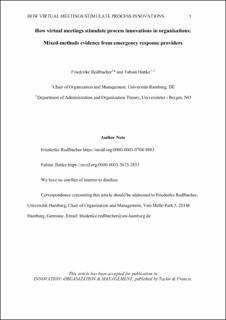| dc.contributor.author | Redlbacher, Friederike | |
| dc.contributor.author | Hattke, Fabian | |
| dc.date.accessioned | 2023-04-14T12:02:23Z | |
| dc.date.available | 2023-04-14T12:02:23Z | |
| dc.date.created | 2022-05-31T16:45:37Z | |
| dc.date.issued | 2022 | |
| dc.identifier.issn | 1447-9338 | |
| dc.identifier.uri | https://hdl.handle.net/11250/3063122 | |
| dc.description.abstract | Although meetings are an omnipresent organisational practice for interactive idea generation, we know little about how the switch to digital forms affects innovation-oriented behaviours in meetings. This sequential mixed-methods study explores the role of virtual meetings in the generation of process innovations in the Ministry of the Interior of the city-state Hamburg in Germany during the first year of the COVID-19 pandemic. Based on observations, informal interviews, documents, group discussions, and an online survey, we combine qualitative and quantitative methods to develop, test, and elaborate on a conceptual model. The model describes how and why the virtual meeting format relates to meeting performance and facilitates process innovations in organisations. Our findings show that digital meetings are perceived as equally burdensome, but more effective than face-to-face meetings. We explain this finding by identifying three shared affordances of virtual meetings: effortless attending, sequential speaking and liberated interacting. We theorise that the mechanisms behind the shared affordances in virtual meetings are process constraints, which turn out to be enabling limits for creative collaboration. We conclude that virtual meetings (unintentionally) bring about brainstorming facilitator rules, spur organisational creativity, and therefore turn out to be an (underestimated) practice for stimulating process innovations. | en_US |
| dc.language.iso | eng | en_US |
| dc.publisher | Taylor & Francis | en_US |
| dc.rights | Attribution-NonCommercial-NoDerivatives 4.0 Internasjonal | * |
| dc.rights.uri | http://creativecommons.org/licenses/by-nc-nd/4.0/deed.no | * |
| dc.title | How virtual meetings stimulate process innovations in organisations: mixed-methods evidence from emergency response providers | en_US |
| dc.type | Journal article | en_US |
| dc.type | Peer reviewed | en_US |
| dc.description.version | acceptedVersion | en_US |
| dc.rights.holder | Copyright 2022 Taylor & Francis | en_US |
| cristin.ispublished | true | |
| cristin.fulltext | postprint | |
| cristin.qualitycode | 1 | |
| dc.identifier.doi | 10.1080/14479338.2022.2045998 | |
| dc.identifier.cristin | 2028561 | |
| dc.source.journal | Innovation: Organization and Management | en_US |
| dc.identifier.citation | Innovation: Organization and Management. 2022. | en_US |

